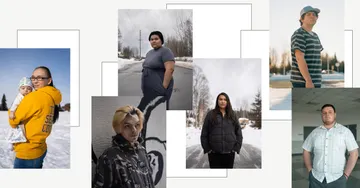Just outside the imposing, brass doors of the federal court building in downtown Manhattan, half a dozen police officers armed with assault rifles stand at the ready, a bristling show of security that signals someone potentially dangerous is inside.
Who might be on trial, however, seems to be anyone’s guess.
“The cop from Staten Island?” wonders Evan Fong, a teenaged student watching the cluster of police vans near the court entrance. He means the New York police officer who was brought before a grand jury last month in the chokehold death of an African-American man, Eric Garner, on Staten Island.
“I thought it was the speaker of the assembly,” says Juliet Lee-Ramos, a school crossing guard who has been reading tabloid coverage about Sheldon Silver, the state assembly leader who was recently arrested on corruption charges.
It is seemingly impossible to find a passersby on this chilly morning who has even heard of Khaled al-Fawwaz, the Saudi man whose trial on the 26th floor of the courthouse has drawn the extra security. Even when they learn he is reputedly one of the ten top-ranking figures in Al Qaeda, and accused in the terror bombings that killed over 200 people in Kenya and Tanzania in 1998, no one hurries to the other side of the street.
“I’m not worried about him,” says Freeman McCrae, an 85-year-old Korean War veteran who is on his way to file a complaint against his landlord in a nearby court. “There could be a whole lot of terrorists right here in New York.”
Such nonchalance would have been inconceivable a few years ago. In 2009, the proposal to try Khalid Shaikh Mohammed, the accused mastermind behind the 9/11 attacks, sent the city into something approaching an uproar. Protesters in downtown Manhattan hurled insults at Attorney General Eric Holder, who had urged the trial be held in federal court. Politicians, especially Republicans, warned that the trial would again turn the city into a prime target for terrorism. Keeping New York safe, they said, would be an impossible logistical and financial challenge.
Even one of the city’s leading liberal voices, Bill de Blasio, then the Public Advocate and now the mayor, insisted that such a trial would be a “mistake.” Prosecuting the case so near to the site of the former World Trade Center, he said, would be to put the trial “literally at the immediate scene of the crime."
Mayor Michael Bloomberg initially supported the trial, saying it was fitting to indict terrorists in the city they had attacked. But then he bowed to the prevailing political winds, and urged the Justice Department to decide the detainees’ fate in military tribunals. A few months later, as the pressure continued, Holder canceled plans for a civilian trial.
But in surprisingly short order, terror trials in Manhattan have become non-events.
In 2010, the trial of Ahmed Khalfan Ghailani was cast as “litmus test” for civilian terror trials. One vocal critic, Liz Cheney, argued it was “further proof that this Administration's policy of treating terrorism like a law enforcement matter is irresponsible and reckless.” But there were no reported demonstrations or security incidents surrounding the trial, which most New Yorkers seemed to greet with a shrug. An ACLU official praised the trial for putting fears about such trials to rest.
The past year has seen two additional trials. In September 2014, Sulaiman Abu Ghaith, a son-in-law of Osama bin Laden, was sentenced to life for his hand in al-Qaeda operations. Earlier this month, Mustafa Kamel Mustafa, a London-based cleric known as Abu Hamza al-Masri, was sentenced to life in prison for terrorist activities.
Inside the federal district court, Fawwaz’s trial runs much like any other. There is no line to pass through the metal detectors outside the courtroom. The dozen or so federal marshals in suits almost outnumber the spectators, who barely fill three rows in the audience.
At 10 a.m., Fawwaz enters from a locked side room. Dressed in a white kaftan and matching kufti, he takes a seat at a table with his defense team. He listens impassively during the morning’s testimony and occasionally passes a note from one of his attorneys to another.
If Fawwaz were to turn around in his chair — on one weekday morning, he never did — he would see past the near-empty courtroom and out through six full-length picture windows. Through the last one, he might catch a glimpse of a recent, iconic addition to the Manhattan skyline: the 104 stories of One World Trade Center, unveiled this year as a reminder of the 9/11 attacks and a symbol of the city’s resilience.
This article has been updated to reflect accurate figures in the 1998 bombings as well as corrected trial dates.
